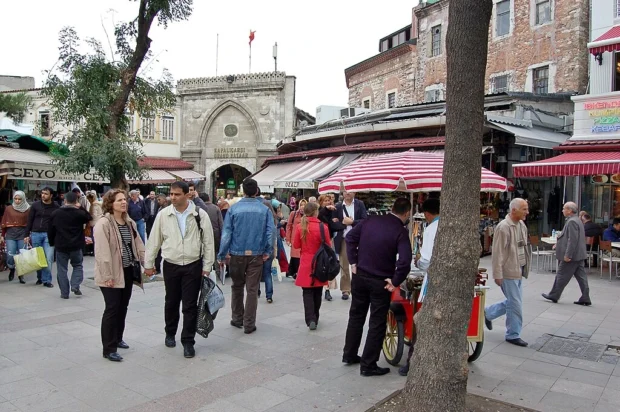In the heart of Istanbul lies the Grand Bazaar, an expansive labyrinth where history whispers through every archway and every corner bursts with radiant colors and the fragrant scents of spices and leather. As a beacon of commerce since the Ottoman era, this market stands as a living testament to Istanbul’s vibrant past and its enduring role as a crossroads of cultures. Navigating this magnificent marketplace, one immerses not only in shopping but also in centuries of craftsmanship and traditions.
Table of Contents
Getting to the Grand Bazaar: Gateway to a Historical Marketplace
Located in the Fatih district, the Grand Bazaar is easily accessible by various modes of transportation, ensuring a smooth journey from anywhere in Istanbul. From the bustling city center, a brief ride on the tram, particularly the T1 line, takes you directly to the stop named Beyazıt-Kapalıçarşı, placing you at one of the main entrances. For those arriving by air, the route includes shuttle services or taxis into the city, followed by trams or buses that weave through Istanbul’s historic peninsula. Even from the main train station, a short walk or a tram ride will bring visitors right to the market’s doorstep.
Nearby Accommodation and Food for Authentic Stays
Surrounding the Grand Bazaar, a mosaic of guesthouses and traditional inns invites visitors to rest within the contours of ancient walls. Staying near the market offers a unique chance to hear the city’s morning calls to prayer alongside the early bustle of traders unfolding their stalls. For meals, the nearby lanes and courtyards feature eateries where one can delight in Turkish cuisine staples-rich kebabs, hearty lentil soup, and the crisp, buttery gozleme. Sampling a cup of çay (Turkish tea) here is a ritual, a moment of calm amid the vibrant market hum.
Through Ottoman Eyes: The Grand Bazaar’s Storied Past
Established in the mid-15th century by Sultan Mehmed II, just a few decades after Constantinople itself was conquered, the Grand Bazaar was designed to fuel the flourishing capital’s economy and to symbolize Ottoman wealth and craftsmanship. One could say this sprawling complex is a living archive, its walls having witnessed centuries of trade routes converging-from the silks of the East to ceramics borne from Anatolian kilns. Despite fires and earthquakes over the centuries, solid restoration practices have preserved its stone architecture and mosaics, ensuring visitors step into a place where time layers richly.
To complement your experience at the Grand Bazaar, exploring the nearby Hagia Sophia reveals another iconic layer of Istanbul’s rich history and architecture.
The Importance as a Cultural and Economic Hub
More than a marketplace, the Grand Bazaar is a melting pot where artisans’ skills in textiles, ceramics, and jewelry are displayed alongside everyday merchant goods. This hub has long been a place where ideas, cultures, and technologies meet, a vibrant reminder of Istanbul’s role as a historic passage linking continents. Walking through its lanes, one can witness the continuation of crafts that shaped regional heritage trails and maintaining a tangible link to the city’s medieval past.
Planning Your Visit: Best Times and How to Navigate Crowds
Choosing when to visit the Grand Bazaar can greatly enhance the immersion. Early mornings on weekdays are ideal for experiencing a more tranquil setting, where shopkeepers have just opened their doors and are keen to share stories or crafts techniques. Mondays and Fridays tend to be busier, especially Fridays after prayers when many locals shop for weekend needs. Seasonally, late spring and early autumn offer temperate weather, making walking through the enclosed market more comfortable.
After savoring the Grand Bazaar’s rich history and vibrant atmosphere, you might appreciate reading about the equally captivating heritage and warm culture of Antalya.
Visitor Tips for a Memorable Experience
- Wear comfortable shoes; the bazaar’s cobblestone floors reveal their age underfoot.
- Bring cash in the local currency, Turkish lira, as many small vendors prefer it over cards.
- Haggle politely-bargaining is part of the experience, reflecting centuries-old trading customs.
- Take breaks at small tea gardens inside the market to refresh and absorb the lively atmosphere.
- Be mindful of your belongings; the busy environment can attract pickpockets.
Organized Tours and Reservations: Do They Enhance the Visit?
While wandering freely allows personal discoveries, participating in guided tours can deepen understanding of the Grand Bazaar’s historical layers and artisan trades. Various tours offer focused walks, including visits to traditional workshops where ceramics and textiles are made. Booking in advance is advisable during peak seasons to ensure availability and often can include multilingual guides who bring to life the architectural details, mosaic reliefs, and the ongoing restoration efforts.
How to Secure a Tour
Many local agencies offer well-structured tours starting from the Sultanahmet area, including hotel pickups and combined visits with other historical monuments nearby. Reservations can be made online or at tourism offices in Istanbul, with flexible options for group sizes and durations.
Additional Insights: What Visitors Often Overlook
Among the thousands of stalls, a subtle detail often missed is the market’s sophisticated water drainage system beneath the floors, a marvel of Ottoman engineering that helped preserve the interiors through centuries of wear. Another curious fact: some shops have occupied the very same spots for generations, their family names tracing back to the market’s founding artisans. Walking through the Grand Bazaar thus becomes not only a shopping journey but a stroll through living history, a narrative of stone carvings, mosaic fragments, and the soft patina of innocence amid the commerce.
For travelers intrigued by Turkey’s rich history, the Cappadocia region offers unique rock formations and underground cities that complement Istanbul’s historic vibe.
Official Resources for Deeper Exploration
For those interested in official information, opening hours, or upcoming cultural events held at the Grand Bazaar, the official webpage provides reliable updates and historical insights. Access the details by visiting the Grand Bazaar official website.

Explorer of historical towns, ancient ruins, and traditional markets, combining modern travel with interest in heritage.
- Grand Bazaar, Istanbul, 2007 (17) by Bahnfrend on Wikimedia Commons – cc by-sa 4.0
